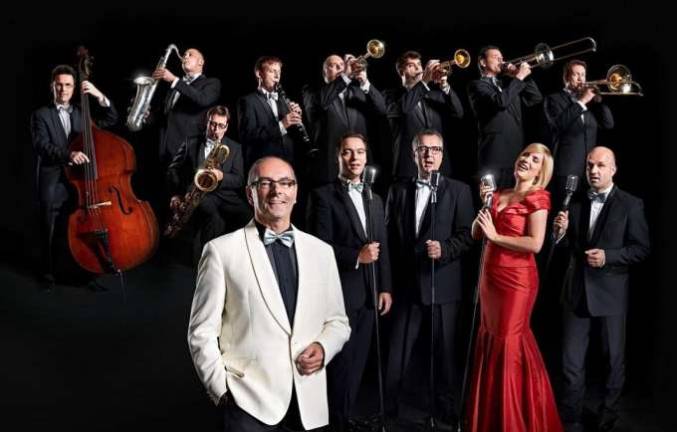Glenn Miller Orchestra at The Newt

NEWTON — The World Famous Glenn Miller Orchestra returns to The Newton Theatre on Sunday December 9, 2018 at 3 PM.
Alton Glenn Miller was born in Clarinda, Iowa on March 1, 1904. But it was in North Platte, Nebraska, several years later that Glenn actually got his musical start when, one day, his father brought home a mandolin. Glenn promptly traded it for an old battered horn, which he practiced every chance he got. In fact his mother worried, “It got to where Pop and I used to wonder if he’d ever amount to anything.”
In 1923, Miller entered the University of Colorado, although he spent more time traveling to auditions and playing where and whenever he could. After flunking three of his five courses one semester, Glenn dropped out to concentrate on his career as a professional musician.
He toured with several orchestras and ended up in Los Angeles where he landed a spot in Ben Pollack’s group, a band that included a guy named Benny Goodman. Here, Miller also got the chance to write some arrangements. Arriving in New York City, he soon sent for, and married his college sweetheart, Helen Burger in 1928, and for the next three years, earned his living as a free-lance trombonist and arranger.
Miller played and recorded with the likes of Tommy and Jimmy Dorsey (who on several of their records, featured an up-and-coming singer by the name of Bing Crosby), Gene Krupa, Eddie Condon and Coleman Hawkins. In addition, during that time, Glenn cut 18 sides for Goodman, and also worked for radio studio conductors like Victor Young, Carl Fenton and Jacques Renard. In 1934, Miller became the musical director of the Dorsey Band, and later went on to organize The Ray Noble Orchestra, which included such players as Charlie Spivak, Peewee Erwin, Bud Freeman, Johnny Mince, George Van Eps and Delmar Kaplan, among others.
In 1937, Glenn Miller stepped out to form his own band. There were a few recordings — one for Decca and one for Brunswick — a couple of week-long stints in New Orleans and Dallas, and many one-nighters, but it was not to be. Though the group would play one more date several days later in Bridgeport, Connecticut, Glenn gave his men their final notice on New Year’s Eve at the Valencia Ballroom in York, Pennsylvania. Broke, depressed and having no idea what he was going to do, he returned to New York City.
Formed in March 1938, the second Glenn Miller Orchestra — which would later include the likes of Tex Beneke, Marion Hutton, Ray Eberle, Paul Tanner, Johnny Best, Hal McIntyre, and Al Klinck — soon began breaking attendance records all up and down the East Coast. At the New York State Fair in Syracuse it attracted the largest dancing crowd in the city’s history. The next night it topped Guy Lombardo’s all-time record at the Hershey Park Ballroom in Pennsylvania. The Orchestra was invited by ASCAP to perform at Carnegie Hall with three of the greatest bands ever — Paul Whiteman, Fred Waring and Benny Goodman — and created more of a stir than any of them.
There were record-breaking recordings, as well, such as “Tuxedo Junction”, which sold 115,000 copies in the first week. “In the Mood”, and “Pennsylvania 6-5000″, all appearing on the RCA Victor Bluebird label.
On October 7, 1942, Alton Glenn Miller reported for induction into the Army and was immediately assigned to the Army Specialist Corps. His appointment as a Captain came after many months of convincing the military higher-ups that he could modernize the army band and ultimately improve the morale of the men. His training complete, he was transferred into the Army Air Corps, where he ultimately organized the Glenn Miller Army Air Force Band. Miller’s goal of entertaining the fighting troops took another year to be realized, but in late 1943 he and the band were shipped out to England.
There, in less than one year, the Glenn Miller Army Air Force Band engaged in over 800 performances. Of these, 500 were broadcasts heard by millions. There were more than 300 personal appearances including concerts and dances, with a gross attendance of over 600,000. But Glenn was not to participate in the final six months of these activities.
In the Fall of 1944, the band was scheduled to be sent on a six-week tour of Europe and would be stationed in Paris during that time. Miller decided to go ahead, in order to make the proper arrangements for the group’s arrival. And so, on December 15th, Glenn Miller boarded a transport plane to Paris, never to be seen again.
Tickets start at just $29 at The Newton Theatre box office at 219 Spring Street in Newton, NJ; online at www.TheNewtonTheatre.com; or by calling 973-940-NEWT.